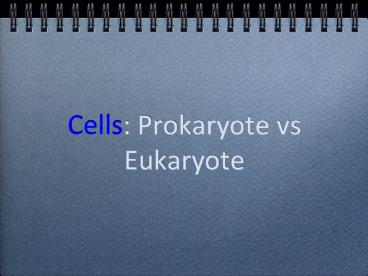Cells: Prokaryote vs Eukaryote - PowerPoint PPT Presentation
1 / 38
Title:
Cells: Prokaryote vs Eukaryote
Description:
Title: Cells: Prokaryote vs Eukaryote Last modified by: atallant Document presentation format: Custom Other titles: Bradley Hand ITC TT-Bold Arial Stone Sans ITC TT ... – PowerPoint PPT presentation
Number of Views:311
Avg rating:3.0/5.0
Title: Cells: Prokaryote vs Eukaryote
1
Cells Prokaryote vs Eukaryote
2
Cells have evolved two different architectures
- Prokaryote style
- Eukaryote style
3
CELL THEORY
- 1. ALL CELLS COME FROM PRE-EXISTING CELLS.
- 2. ALL LIVING ORGANISMS ARE COMPOSED OF 1 OR
MORE CELLS - 3. CELLS ARE THE BASIC UNIT OF ALL LIVING
ORGANISMS
4
Prokaryote cells are smaller and simpler
- Commonly known as bacteria
- Single-celled(unicellular) or
- Filamentous (strings of single cells)
5
These are prokaryote E. coli bacteria on the
head of a steel pin.
6
Prokaryote cells are simply built (example E.
coli)
- capsule slimy outer coating
- cell wall tougher middle layer
- cell membrane delicate inner skin
7
Prokaryote cells are simply built (example E.
coli)
- cytoplasm inner liquid filling
- DNA in one big loop
- pilli for sticking to things
- flagella for swimming
- ribosomes for building proteins
8
Prokaryote lifestyle
- unicellular all alone
- colony forms a film
- filamentous forms a chain of cells
9
Prokaryote Feeding
- Photosynthetic energy from sunlight
- Disease-causing feed on living things
- Decomposers feed on dead things
10
Eukaryotes are bigger and more complicated
- Have organelles
- Have chromosomes
- can be multicellular
- include animal and plant cells
11
Unicellular Eukaryotes
- AMOEBA-
- FLAGELLATE-
- CILLIATE-
12
UNICELLULAR VIDEO
- Brain eating ameoba
- Paramecium movement
13
Organelles are membrane-bound cell parts
- Mini organs that have unique structures and
functions - Located in cytoplasm
14
Cell Structures
- Cell membrane
- delicate lipid and protein skin around cytoplasm
- found in all cells
- GATE KEEPER OF CELL
15
- Nucleus
- a membrane-bound sac evolved to store the cells
chromosomes(DNA) - has pores holes
- OFFICE OF CELL
16
- Nucleolus
- inside nucleus
- location of ribosome factory
- made or RNA
17
- mitochondrion
- makes the cells energy
- the more energy the cell needs, the more
mitochondria it has - BATTERY OF CELL
18
- Ribosomes
- build proteins from amino acids in cytoplasm
- may be free-floating, or
- may be attached to ER
- made of RNA
19
- Endoplasmic reticulum
- may be smooth builds lipids and carbohydrates
- may be rough stores proteins made by attached
ribosomes - MANUFACTURING DEPTARMENT
20
- Golgi Complex
- takes in sacs of raw material from ER
- sends out sacs containing finished cell products
- FED EX OF THE CELL OR POST OFFICE
21
- Lysosomes
- sacs filled with digestive enzymes
- digest worn out cell parts
- digest food absorbed by cell
- GARBAGE TRUCK
22
- Centrioles
- pair of bundled tubes
- organize cell division
23
Cytoskeleton
- made of microtubules
- found throughout cytoplasm
- gives shape to cell moves organelles around
inside.
24
Structures found in plant cells
- Cell wall
- very strong
- made of cellulose
- protects cell from rupturing
- glued to other cells next door
25
- Vacuole
- huge water-filled sac
- keeps cell pressurized
- stores starch
- WAREHOUSE OF CELL
26
- Chloroplasts
- filled with chlorophyll
- turn solar energy into food energy
27
How are plant and animal cells different?
28
Structure Animal cells Plant cells
cell membrane Yes yes
nucleus Yes yes
nucleolus yes yes
ribosomes yes yes
ER yes yes
Golgi yes yes
centrioles yes no
cell wall no yes
mitochondria yes yes
cholorplasts no yes
One big vacuole no yes
cytoskeleton yes Yes
29
Eukaryote cells can be multicellular
- The whole cell can be specialized for one job
- cells can work together as tissues
- Tissues can work together as organs
30
Advantages of each kind of cell architecture
31
- sperm cell specialized to deliver DNA to egg cell
32
- Mesophyll cell
- specialized to capture as much light as possible
- inside a leaf
33
How do animal cells move?
- Some can crawl with pseudopods
- Some can swim with a flagellum
- Some can swim very fast with cilia
34
Pseudopods
- means fake feet
- extensions of cell membrane
- example ameoba
35
Flagellum/flagella
- large whiplike tail
- pushes or pulls cell through water
- can be single, or a pair
36
Cilia
- fine, hairlike extensions
- attached to cell membrane
- beat in unison
37
Endo insideSymbiont friend
38
- the small prokaryotes that can do photosynthesis
evolve into chloroplasts, and pay their host
with glucose. - The smaller prokaryotes that can do aerobic
respiration evolve into mitochondria, and convert
the glucose into energy the cell can use. - Both the host and the symbiont benefit from the
relationship































